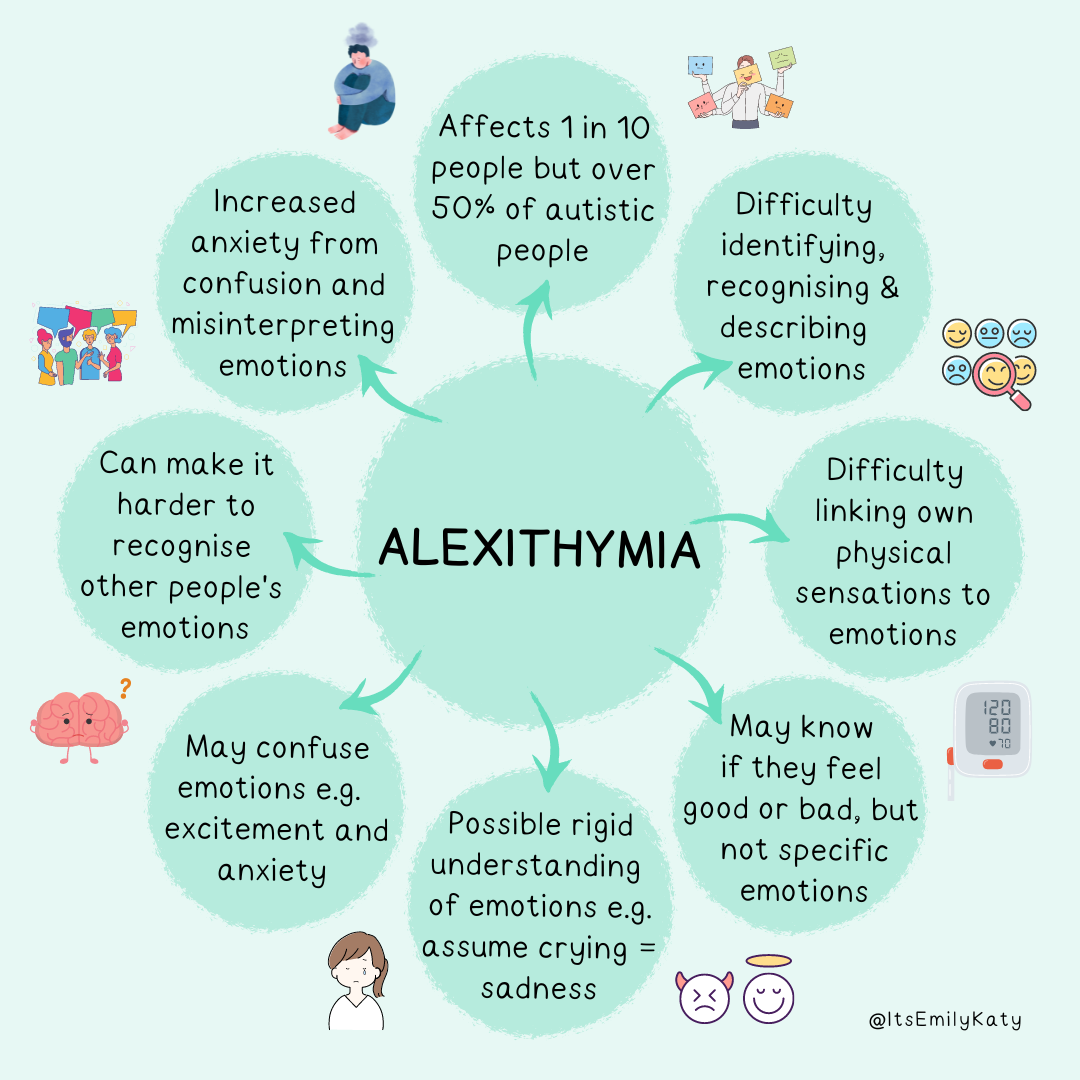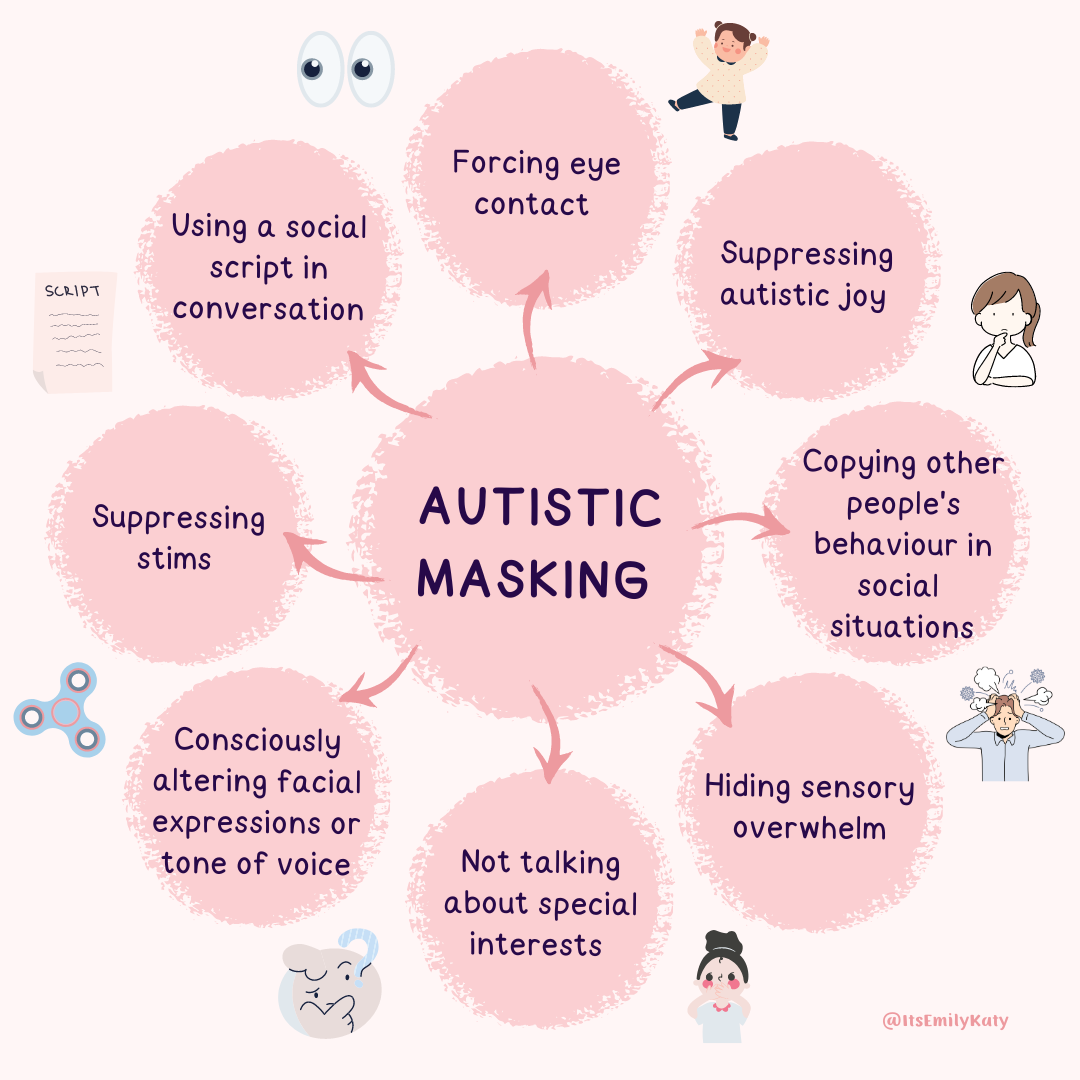Autism and Mental Health: Why do so many autistic people struggle?
Research suggests that 80% of autistic people experience mental health problems throughout their life, and around 40% of suicides are estimated to be autistic people (Autistica, undated; Cassidy et al. 2022). This is incredibly sad.
There are a variety of reasons why this might be the case.
Lack of Recognition
Research shows that autistic people diagnosed later in life have an increased risk of poor mental health and a lower quality of life (Atherton et al., 2021). And there are a LOT of autistic people who aren’t recognised, and increasing numbers being diagnosed later in life.
Autistic people of marginalised genders or minority ethnic groups are less likely to receive a diagnosis. 80% of autistic girls remain undiagnosed after the age of 18 and are diagnosed later than their male counterparts (McCrossin et al., 2022). Justice for Black Girls (2024) state that “many Black women and girls do not receive ASD diagnoses as children, if ever, because they don’t fit the white-male centred profile of autism.”
Not recognising (as well as not supporting) autism can have a detrimental effect on people’s mental health. It is important for autistic people to be recognised because:
There are high rates of mental illness and suicidality amongst autistic people (Lever & Geurts., 2016; Cassidy et al., 2014)
Not knowing you are autistic has negative consequences on individual’s well-being and functioning
There are high rates of undiagnosed autistic people presenting to mental health services (Nyrenius et al., 2022)
There is widespread misdiagnosis such as Emotionally Unstable Personality Disorder, which causes harm and incorrect treatment to be offered (Au-Yeung et al., 2018)
If therapies aren’t adapted for autistic people, this can cause harm (Bargiela et al., 2016)
Autistic people are then more likely to access reasonable adjustments and understand their own needs
They may be able to access additional support
2. Lack of Understanding and Support
It is not just the recognition of autism that is needed to enable an autistic person to thrive, but the understanding and support alongside it.
“I want to make clear, though, that the journey of an autistic person who was diagnosed at an early age will not necessarily have been easier. Although it has the potential to, a diagnosis does not automatically lead to understanding and support, so it is not everything. Those diagnosed younger may have been forced into harmful therapies or institutions, learned to view autism as something inherently ‘bad’ or ‘wrong’ with them, and grown up experiencing just as many challenges. Likewise, somebody diagnosed later may have been well supported in their home and school environment, and had their needs catered for, just without a diagnosis.”
3. Ableism and Discrimination
Autistic people battle ableism frequently, and it is exhausting. We may experience discrimination, for example in the workplace. This is more common amongst autistic people who are also part of other marginalised groups.
Archuleta Chisolm says in ‘Autistic While Black’ that “Cultural stereotypes make it especially dangerous to be autistic while Black. Part of the reason people are quick to stereotype is that there is little to no research on Black women and girls with autism.” Black autistic people face additional risks because of racism, lack of cultural understanding and discrimination.
Autistic people are more likely to be LGBTQ+ than non-autistic people, increasing their likelihood of facing discrimination and abuse (Weir et al., 2021).
Additionally, autistic people with higher support needs, non-speaking autistics and those unable to mask sadly face increased barriers to society, increased risks of danger and increased ableism.
This undoubtedly has a big impact on autistic people’s mental health.
4. Experiences of Trauma
Unfortunately, autistic people are more likely to have experienced forms of trauma than the general population. Half of autistic adults have been abused by somebody who they thought was their friend (McVeigh, 2014). We are more likely to have been bullied, making us more vulnerable to experiencing depression, anxiety, despair and isolation (Toseeb et al., 2020; US Department of Health and Human Sciences). We are also more likely to have been sexually assaulted than non-autistic people. Autistic women are between two to three times more likely to have been sexually assaulted than non-autistic women (Cazalis et al., 2022).
These statistics are incredibly sad, and it is no wonder our mental health is impacted.
5. Alexithymia
Alexithymia, translating to ‘no words for emotion in Greek’, is where someone has difficulty identifying and describing emotions. This is particularly common amongst autistic people. Research suggests it effects approximately 50% of us (Kinnaird et al., 2019). It is linked to interoceptive difficulties, meaning the challenges we have recognising bodily sensations/feelings, such as hunger or when we need the toilet.
Not knowing how you are feeling can be confusing and dysregulating. We may find expressing our emotions hard, so demonstrate them through outward ‘problematic’ behaviours. Alexithymia can then affect our ability to engage with psychological therapies and is one reason why adapted therapies are so essential.
6. Masking
The effect masking has on our mental health can be significant. Although masking can be useful at times for those of us who can mask (for example, for safety), research shows the negative effect that it has on our mental health (Cage & Troxell-Whitman, 2019). Masking is linked with high levels of anxiety and contributes to the risk of autistic burnout (Hull et al., 2021; Raymaker et al., 2020).
7. Life is Challenging to Navigate!
Life can be difficult for everyone, but having an autistic brain can make day to day life even more challenging to navigate. It is also exhausting having to deal with these things on a daily basis.
Confusion from taking things literally and black and white thinking
Dealing with uncertainty
Sensory environment
Anxiety around change
Crowds and busy places
High levels of anxiety
Facing ableism
Processing information differently
Having difficulty interpreting instructions
Navigating relationships
Unclear social rules and expectations
Feeling frequently overwhelmed
Exhaustion from masking
Dealing with all of these things takes a toll on our mental health.
“It is no surprise that research has shown that 80 per cent of autistic people experience mental health problems at some stage in their lives, the most prevalent being depression and anxiety.
I don’t even know how you begin to disentangle anxiety and autism in our current world. Constantly balancing routine, emotions and the scales of anxiety requires a huge amount of effort, in order to avoid uncontrollable meltdowns or panic attacks that render us exhausted.
It is no wonder so many autistic people have anxiety, when our minds thrive on things the world does not offer, like predictability, routine and literality. Nor that so many have depression, when the world constantly shouts at us that we don’t deserve to be accepted for who we are. Nor that so many have eating disorders, when bullying and trauma make us hate ourselves and we seek control over a world that feels so out of control.”
I know this is all rather depressing, but the good news is that with the right support, understanding and environment, autistic people can thrive. There are many of us who have struggled and now thrive, with the right support in place.
Stay tuned for a blog post with practical advice for managing mental health. Until then, thank you for reading.
GIRL UNMASKED (The Sunday Times Bestseller) is available to order from Amazon and all major bookstores! https://linktr.ee/girlunmasked
References:
Amos, G., A., Byrne, G., Chouinard, P. A. & Godber, T. (2018). Autism traits, sensory over-responsivity, anxiety, and stress: a test of explanatory models. Journal of Autism and Developmental Disorders, 49, 98-112. https://doi.org/10.1007/s10803-018-3695-6
Atherton et al. (2022). Autism through the ages: a mixed methods approach to understanding how age and age of diagnosis affect quality of life. Journal of Autism and Developmental Disorders, 52(8), 3639-3654. https://doi.org/10.1007/s10803-021-05235-x.
Autistic Girls Network. (2022). Autism, girls and keeping it all inside. https://autisticgirlsnetwork.org/wp-content/uploads/2022/11/Keeping-it-all-inside.pdf
Autistica. (undated). Autism and mental health. https://www.autistica.org.uk/downloads/files/Mental-health-autism-E-LEAFLET.pdf
Au-Yeung, S., Bradley, L., Robertson, A., Shaw, R., Baron-Cohen, S. & Cassidy, S. (2018). Experience of mental health diagnosis and perceived misdiagnosis in autistic, possibly autistic and non-autistic adults. Autism, 23(6), 1508-1518. https://doi.org/10.1177/1362361318818167
Bargiela, S., Steward, R. & Mandy, W. (2016). The experiences of late-diagnosed women with autism spectrum conditions: an investigation of the female autism phenotype. Journal of Autism and Developmental Disorders, 46(10), 3281-3294. https://doi.org/10.1007/s10803-016-2872-8
Beardon, L. (2017). Autism and Asperger Syndrome in Adults. Sheldon Press.
Brinkert, J. & Remington, A. (2020). Making sense of the perceptual capacities in autistic and non-autistic adults. Autism, 24(7). https://doi.org/10.1177/1362361320922640
British Psychology Society. (2017). Psychology at work: improving wellbeing and productivity in the workplace. https://www.researchgate.net/publication/335992150_Psychology_at_work_Improving_wellbeing_and_productivity_in_the_workplace
Cage, E. & Troxell-Whitman. (2019). Understanding the reasons, contexts and costs of camouflaging for autistic adults. Journal of Autism and Developmental Disorders, 49(5), 1899-1911. https://doi.org/10.1007/s10803-018-03878-x.
Cassidy, S., Bradley, P., Robinson, J., Allison, C., McHugh, M. & Baron-Cohen, S. (2014). Suicidal ideation and suicide plans or attempts in adults with Asperger’s syndrome attending a specialist diagnostic clinic: a clinical cohort study. Lancet Psychiatry, 1, 142-147. https://doi.org/10.1016/s2215-0366(14)70248-2
Cassidy et al. (2022). Autism and autistic traits in those who died by suicide in England. The British Journal of Psychiatry. https://doi.org/10.1192/bjp.2022.21
Cazalis, F., Reyes, E., Leduc, S. & Gourion, D. (2022). Evidence that nine autistic women out of ten have been victims of sexual violence. Frontiers in Behavioral Neuroscience, 16, Article 852203. https://doi.org/10.3389/fnbeh.2022.852203
Chisolm, A. (undated). Autistic While Black. https://blackgirlnerds.com/autistic-while-black/
Grove, R., Hoekstra, R. A., Wierda, M. & Begeer, S. (2018). Special interests and subjective wellbeing in autistic adults. Autism Research, 11(5), 766-775. https://doi.org/10.1002/aur.1931
Hull, L., Levy, L., Lai, M., Petrides, K. V., Baron-Cohen, S., Allison, C., Smith, P., Mandy, W. (2021). Is social camouflaging associated with anxiety and depression in autistic adults? Molecular Autism, 12. https://doi.org/10.1186/s13229-021-00421-1
Justice for Black Girls. (2024). https://www.justiceforblackgirls.com/
Kinnaird, E., Stewart, C. & Tchanturia, K. (2019). Investigating alexithymia in autism: a systematic review and meta-analysis. European Psychiatry, 55(80-89). https://doi.org/10.1016/j.eurpsy.2018.09.004.
Lever, A. & Geurts. H. (2016). Psychiatric co-occurring symptoms and disorders in young, middle-aged, and older adults with autism spectrum disorder. Journal of Autism and Developmental Disorders, 46, 1916-1930. https://doi.org/10.1007/s10803-016-2722-8
McCrossin, R. (2022). Finding the true number of females with autism spectrum disorder by estimating the biases in initial recognition and clinical diagnosis. Children (Basel), 9(2), 272. https://doi.org/10.3390/children9020272.
McVeigh, T. (2014, Jun 14). Half of autistic adults “abused by someone they trusted as a friend.” The Guardian. https://www.theguardian.com/society/2014/jun/14/autistic-adults-abused-by-friends-survey
Nyrenius et al. (2022). Prevalence of autism spectrum disorders in adult outpatient psychiatry. Journal of Autism and Development Disorders, 2022. https://doi.org/10.1007/s10803-021-05411-z
Raymaker et al. (2020). “Having all of your internal resources exhausted beyond measure and being left with no clean–up crew”: defining autistic burnout. Autism Adulthood, 2(2), 132-143. https://doi.org/10.1089/aut.2019.0079
Toseeb, U., McChesney, G., Oldfield, J. & Wolke, D. (2020). Sibling bullying in middle childhood is associated with psychosocial difficulties in early adolescence: the case of individuals with autism spectrum disorder. Journal of Autism and Developmental Disorders, 50, 1457-1469. https://doi.org/10.1007/s10803-019-04116-8
Weir, E., Allison, C. & Baron-Cohen, S. (2021). The sexual health, orientation, and activity or autistic adolescents and adults. Autism Research, 14(11), 2342-2354. https://doi.org/10.1002/aur.2604.


